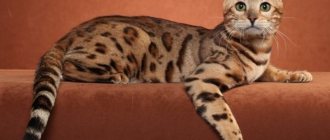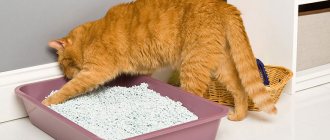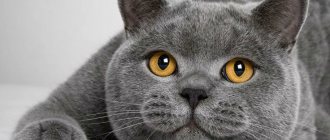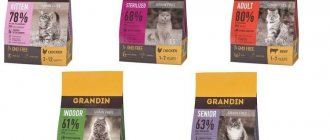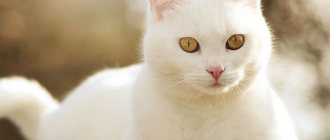Story
The Bengal cat breed is the result of crossing domestic cats with wild Asian Leopard cats (Prionailurus bengalensis). The Latin word “Bengalensis” became part of the name of the breed, and the history of its breeding became a story of true enthusiasm, perseverance and patience. There have been rumors about attempts to domesticate the beautiful and graceful, but completely wild Asian leopard cats (or cross them with domestic ones) since the 70s of the 19th century. But by the middle of the twentieth century, the spotted cats of Southeast Asia were on the verge of extinction. Poachers shot cats for their beautiful fur, and the kittens were sold in street markets as living souvenirs. Tourists, when buying these kittens, did not understand that they were getting a wild animal; as a result, the fate of most kittens was sad and short-lived.
In the early 1960s, one such cat was brought from Thailand by the American Jean Mill, a woman who was to play an active role in the breeding and dissemination of the Bengal breed. A geneticist by profession, Jean Mill has been interested in cat breeding since her student years. Back in 1946, while a student at the University of California, Davis, she wrote a course paper on the crossing of cat breeds. The cat she brought to America, named Maleija, although shy of people, became friends with the neighbor’s black cat.
The result of the friendship was the only surviving female kitten, Kinkin, with the same exotic color as her mother. And although this experience of crossing a wild cat with a domestic cat did not continue, it left a mark on the owner’s soul. Jean Mill was confident that her knowledge of genetics, coupled with perseverance and patience, would bear fruit. The vast majority of scientists of that time were confident that it was impossible to obtain a stable breed from a hybrid. It’s one thing when you cross a leopard cat with a domestic cat and, as a result of persistent selection, you get a hybrid - a “domestic leopard”, beautiful and tamed, but unable to pass on its characteristics to its descendants, or even completely sterile. Another thing is to develop a full-fledged breed, the representatives of which can, by crossing with each other, pass on stable characteristics to new generations. In the late 1960s, American animal rights activist and cat enthusiast Bill Engler made the first notable successes in producing leopard-domestic cat hybrids. Bill Engler bred ocelot cats, devoted much effort to rescuing and preserving wild Asian and exotic breeds, and even trained cats for film and television. In 1970, he received the first successful offspring of “domestic leopard” hybrids and was filled with enthusiasm, but alas, already in the third generation his hybrids were infertile. It was Bill Engler who gave his cats the name “Bengal” (they say that his name is encoded in this name: B-engle) and in 1974 he registered this name for the future breed. Bill Engler never managed to complete the job. He died in 1977, and among modern cats of the Bengal breed there is not a single descendant of his once bright, but hybrids that have sunk into oblivion. At the same time, when Engler was trying to breed his “domestic leopard,” medical scientists suddenly began crossing domestic and leopard cats.
But their goals were infinitely far from breeding: it turned out that the genome of Asian leopard cats completely lacks the gene responsible for “switching on” feline leukemia, the most dangerous cancer. Crossing leopard cats with domestic cats opened up new prospects for scientists in the study of genes responsible for the hereditary transmission of a number of diseases in both cats and humans. The research was led by Dr. William Centerwall, a medical scientist and big cat lover, professor of pediatrics, geneticist and author of several works on feline genetics. Dr. Centerwall distributed the hybrid kittens born during the research to his colleagues, among whom was the already mentioned Jean Mill. Jean began breeding with renewed vigor, but it was all in vain: the hybrid kittens either turned out to be infertile, or grew up to be as wild as their ancestors, or lost the external features of leopard cats. Jean Mill was clearly missing some missing link that would bind the beauty of wild cats and the easy-going nature of domestic cats into a stable breed. Simultaneously with Jean Mill's experiments, other breeders - the spouses Greg and Elizabeth Kent - came up with the idea of “mixing” another breed into the hybrid of leopard and domestic cats - the Egyptian Mau. Their endeavor was a success. “Egyptian” genes gave the hybrid the very stability that breeders had long sought. Jean Mill did a similar trick, for which she had to get an Indian Mau cat (or an ordinary Indian cat) in India, from the curator of a zoo in New Delhi. With the advent of Mau cats, the puzzle came together, and in 1983, as a result of the active efforts of Jean Mill, the new breed received official recognition. All modern Bengal cats descend from one of the first two lines - Egyptian and Indian.
Origin story
The Asian leopard is a small member of the cat family with the typical golden-brown color and silky coat of these animals. In the middle of the last century, due to the outrages of poachers, this species was almost completely destroyed: adult animals were shot for their skins, and babies were sold in souvenir shops.
Wanting to save animals from extinction, American scientist Jean Mill began experiments on crossing leopards with domestic cats of various breeds. The first experiments were unsuccessful; hybrid kittens were born and grew up aggressive and unsociable.
But after two decades of experimental crossbreeding, the domestic Bengal cat was bred with a stunning coat of glitter, called glitter, and a wild spotted pattern. Representatives of the Bengal breed, as a result of long-term selection, have retained the charm of their wild ancestors, while becoming tame and domesticated.
Description of the breed
| Breed name: | Bengal cat |
| Country of origin: | USA |
| Time of origin of the breed: | 19th century |
| Weight: | 3.6 – 6.8 kg |
| EMS code: | BEN |
| Lifespan: | 12 – 16 years old |
| Price of kittens: | 370 – 1450 $ |
| The most popular nicknames: | list of nicknames for bengal cats |
Bengals are inquisitive, active and sociable, like most domestic cats, but their semi-wild origin has introduced some features into their temperament and behavior:
- Domestic leopard cats are very active, love active games with their owner and other pets, and get along well with dogs, of which they are not at all afraid.
- They love heights, and if you don't want them to choose furniture, curtains and curtains as exercise equipment, provide them with the opportunity to climb special ladders. The Bengal house can also be placed at a height. It is better to close the windows with bars to prevent falls and injuries.
- Bengals have inherited a love of water from leopards; they can play with a trickle for hours, love to take a bath and, without a twinge of conscience, will put their paw into an aquarium.
- The Bengal cat has a very special voice, also inherited from the wild cat. It ranges from a gentle purr to a growl. These animals are very talkative and perfectly distinguish human speech.
- High intelligence and a desire for interaction make it possible to train Bengals and teach them simple commands.
Breed standard - appearance
The modern standard of the breed is due to long-term selection, but work is constantly being done to improve the genotype. If twenty years ago the domestic Bengal cat had predominantly a basic leopard color, now their list has been expanded.
The main description of a Bengal cat is its color; among the possible options, three main groups can be distinguished:
- original Leopard Brown Tabby;
- silver color;
- a series of white, or snow colors, Snow Bengals.
The acceptable patterns for this breed are spots, rosettes or stripes. As a result, a Bengal cat can be of almost any color, from light golden to chocolate, almost white or silver, the only requirement is that it has a typical pattern.
In the first two color groups, eye color varies from yellow and honey to green, and cats of the Snow Bengals colors can have blue and aquamarine eyes. The coat is thick, silky in structure, the undercoat is dense. Bengals are not prone to noticeable shedding.
Mandatory conditions for any color are black paw pads and the tip of the tail, as well as the shine of the coat - glitter.
Character
Bengal cats are loving, loyal and very responsive. They build strong relationships with their owners and become their friends for life. They willingly communicate with people and sincerely reveal their feelings to them. Bengals are very talkative, capable of making a wide range of sounds - from chirping to creaking and screaming. Some of them growl while eating. Bengal cats love to walk on a leash and play in water.
They are very active and therefore require attention. The intelligence of Bengalis allows them to “study” people’s actions and repeat them: for example, opening cabinets, doors, and even windows. They can master many tricks and learn to play various games. True, owners of Bengal cats are not always happy that their cat likes to turn the lights on and off or flush the toilet. Owners of Bengal cats note that aggression is completely absent in the character of this breed.
What remains of the Bengals from their wild ancestors? Firstly, they don't like to be picked up or cuddled. This is a character trait, and not at all a sign of unfriendliness. A Bengal cat won't scratch to be released, but will love you even more if you treat her with respect.
Secondly, Bengal cats love water, especially flowing water. Some only occasionally put their paw under the running water from the tap, others will ask you to join you in the bath or frolic in the shower, as long as it’s their idea, of course. It's cute when a cat takes a bath with its owner, but the owner doesn't always like it when the pet jumps out of the bath and runs around like crazy, splashing water all over the house. Some owners report that their Bengal cats' fascination with water borders on obsession, and such owners quickly learn to keep bathroom doors and toilet lids closed.
Personality of Bengal cats
Author: Elena Zanevskaya, nursery GREENSTYLE © (reprint only with permission of the author) Have you ever communicated with a 5-year-old child? — When communicating with a Bengal cat, you will have approximately the same feeling...
These are active, agile cats, quick to rise
Up to 6 months, Bengal babies most often move by running or skipping. And quite quickly. They follow literally on your heels, jumping between your legs and through any open door with their tails twitching with curiosity. Watch your step!!!
The Bengal cat will become full members of your family
After 6 months, Bengal kittens grow up, gain knowledge, height and weight and move around the house at a trot or at a normal pace. But still, at any age, Bengal cats are interested in all household chores as a member of the family and take an active part in them.
This is what attracts Bengals. While a fluffy Briton or a Scot will sit and yawn, contemplating you like a TV announcer, a Bengal cat will enthusiastically rush to the rescue. Everyone will appreciate such friendly support! A Bengal cat will be a bright addition to your home life and will highlight its taste.
- If you come home full of work problems, then the Bengal cat will take all measures to switch you off and cheer you up.
“And if you’re in a good mood, then there’s nothing funnier than the sight of a Bengal cat running around the room with a fluffy tail like a squirrel’s.”
— Yes, from time to time they will pick your hand with their paw and distract you from the computer, but sometimes this is useful, right? 
Bengal kittens and children
The intelligence of a Bengal kitten at 4 months corresponds to approximately the human age of 4-5 years. So your child and the little leopard will become real friends. I agree that a Bengal kitten will help you raise your child and make him more attentive, sensitive and caring. This sweet couple will study lessons, play, swim and sleep together. With your control and with the correct attitude of the child towards the kitten, they will become true friends. Your child will share some tasty treats with the kitten; a living, responsive creature will help him better overcome some failures.
Bengal cats are surprisingly tolerant of children; they feel that they are small creatures. For their part, they will never harm your child. On your part, please teach your child not to lift the kitten like a doll (by the paws or neck) and ask him not to hug the kitten tightly, squeezing him in his arms. The kitten weighs only 2.5-3 kg, your child will hurt it. (I'll talk about this in more detail a little later in a separate article).
Bengals are very curious cats.
They will poke their nose into any household event, picking and examining any unfamiliar object with their little paws. Many unknown objects are immediately tested.
When you leave your purse on a chair, rest assured, a little customs officer will climb inside and examine all the contents for the game. For them, a person at this age is like a mother (or father) and an entertainer.
However, the Bengal kitten will calmly withstand your absence from work. He will sleep and play his quiet games. Bengal cats easily adapt to your sleep and rest schedule, going about their business in your absence and delighting you with their attention when you are at home.
The most important thing for keeping a Bengal cat or cat
Make sure that there is a reliable protective mesh on the windows (anti-cat) and develop the following habits: check the washing machine hatch before starting and look at your feet when you enter the house.
Bengal cats are ideal hunters
Here you will see all the secrets of the Bengal ancestors - wild Asian dwarf leopards.
Bengal cats quickly switch from one type of activity to another, are surprisingly patient, focused and persistent in achieving their goals. They are ready to sit motionless by the window for hours if the birds have chosen your windowsill. Again and again they will invent attempts to catch them.
Most likely, you will not have flies and butterflies accidentally flying into your house: in pursuit of the target, the Bengals forget about everything, jump high and attack with lightning speed. That is why your windows should be 100% protected from falling out by these gambling hunters.
After playing with feather fiddles, please put them higher in the closet: the toy you forgot will be “killed” and torn to pieces in 15-20 minutes.
If you have an aquarium, you need to cover it from above.
The Bengal gait is not the same as that of ordinary cats. The swing comes from the very shoulder, a relaxed soft paw. Everything is like wild leopards: imposing, silent, soft gait. They disappear and reappear seemingly out of nowhere.
Can you imagine? You are sitting with guests, and suddenly... silently stepping with soft paws, a LEOPARD enters the room. Shock and admiration at the same time!
A bright color on a silk skin, these leopard print rosettes on gold are actually a good protective mimic color. Bengal will completely dissolve and disappear in the grass and fallen leaves like a boletus mushroom. You need to remember this and take your Bengal cat for a walk only on a strong harness and leash.
The nuances of keeping Bengal cats
If you need a Bengal kitten “for yourself” and just as a companion, remember: a good Bengal is a neutered Bengal. The blood of wild ancestors makes itself felt. Bengal cats and cats mature very quickly.
Bengal cats scream loudly and call the cat. They are record holders for tags. Retraining them is difficult and unnecessary: you can simply break their psyche.
Some cats may start their first heat at 6 months. During this period, they meow loudly and passionately for days. Bengal cats bought as pets, and for some reason not sterilized on time, can also significantly ruin your mood with their loud, persistent cries.
Some Bengal beauties begin to mark during heat, just like cats. Most often, this is done by alpha cats by nature, or with “star fever” (we love and pamper them, don’t we?), with leadership habits. They do this occasionally. And not all cats, about 20% of the total. If your cat starts doing this, then it will happen every time she is in heat. This is very unpleasant: both your sofa and the corners of the cabinet may be damaged.
Therefore, all boys and girls that our GREENSTYLE nursery gives to the family as pets are neutered before moving to you, at our expense, in order to save you from possible hassle.
It is these difficulties in keeping unsterilized Bengal cats and stud cats that determine the high cost of Bengal kittens.
When purchasing a gorgeous leopard for your family from other breeders, please make sure to visit a veterinarian regarding this issue as soon as possible, before puberty (6 months).
Bengals are the only breed that does not lose its activity after castration/sterilization.
Bengal cats are very sociable and talkative.
If you listen and watch them, Bengal cats have a wider range of sounds they make. In addition to the usual meows and purrs, Bengals can speak in different tones, either using ligaments or making real vocal sounds.
These are the cats that give “feedback” well. They may assent, or say hello, or gently ask you to pet them, or take them in your arms.
By the way, scientists believe that cats learn to meow only out of a desire to communicate with a person. The more you talk to them, the more tones of voice they will use.
Of course, if you are quiet at home, then your Bengal cat will talk to you less. But how nice it is when in the evening a silky golden leopard jumps onto the sofa next to you, gently touches you with its paw and, looking into your eyes, asks: “Purr, maybe you can pet me?” Believe it or not, when Bengal cats hear unfamiliar sounds or see strangers in their home, they often growl. This is not a threat, rather a defensive reaction, like “Don’t come closer, I’m afraid of you!”
And the screams... oh yes, here Bengal cats take the lead in vocals... Basically, they emit them out of fear in an unfamiliar environment. You can hear it when a terrified Bengal rides in a carrier for the first time in his life. A piercing meow (on ligaments) is heard by the entire bus. But we are also frightened by some new events, aren’t we? The first time is always scary.
Bengal cats are very smart, creative and inventive.
If you have an empty box, then your Bengal cat will figure out how to get into it))
Many Bengal cats learn to open doors. At one time I had a Bengal cat who loved to sleep with the lights on and learned to jump up and press the switch. Another Bengal cat likes to clean his teeth after eating by chewing on his favorite string.
In the heat of her research, a Bengal kitten can slip into a narrow gap between a closet and then scream for you to get her out of there.
Bengal cats are highly trainable and love to fetch small toys in their teeth. They can be trained to fetch something on command. They quickly remember their name, respond and can remember more than 20 word commands.
Bengal cats and water
Only lazy people haven’t written about Bengals’ love of water.
Bengal cats and cats are excellent fishermen. They do this quickly and successfully.
Judging by their domestic habits, you will notice that Bengal cats do not withdraw their paws with disgust when they fall into a puddle on the floor. Moreover, cats of my line like to first “rinse their hands” before drinking.
One of my favorite games is to sit and watch a dripping faucet and catch the stream of water with my paw. Bengals do not panic if they get wet: water is a familiar environment for them.
They are not afraid of being washed in the bathroom, and the noise of the shower does not particularly disturb them, so wait for your Bengal pet in your bathroom. If in the heat you pour water into a wide container, then most likely the Bengal cat will splash in it and play with the toys you brought, and he will throw small balls in there himself. Don't forget to dry your little friend afterwards! )))
Bengals are leaders by nature
If you have a cat at home, then over time it will have to become second in the cat hierarchy. No no! It is not won by fighting! Bengal kittens are so confident in themselves, so crazy curious and so fast that even if they receive a paw on the forehead from your indignant cat, they will be the first to fly up to the bowl of food, the first to react to the wiggle, the first to jump on your lap and quickly occupy the most trump warm place to sleep. They will only be the first, they have it from birth.
After such an impudent arrangement of places, the Bengal cat calms down and begins to peacefully take care of your cat, she takes his impudent character for granted, and they bask together next to her, playfully fight or run after each other.
Bengals are social cats
Bengals are very fond of joint games, in which they strive to involve all family members. They love active running, jump high, and go well with other cats and dogs. Since it is difficult to constantly support such an active cat, they are often paired with another pet, similar in temperament. When a second Bengal appears in the house - a play partner, the Animal Planet channel takes a break. In joint games and communication between two cats, you will see a lot of new and interesting things for yourself. And, at least, finally, your Bengal cat will stop playing with your legs when you fall asleep))) The most important thing: if a Bengal cat makes a new friend, then the attention to you remains at the same level, as all Bengal breeders have been doing for years cats are selected specifically for the priority of friendship with humans.
Bengal cats are good climbers
In nature, the wild ancestor of Bengal cats, the Asian dwarf leopard, can move along tree branches for hours. Therefore, a Bengal cat can easily, without effort, jump onto the kitchen table from a sitting position. When frightened, the jump height is greater, up to 2 meters. If your cabinet sections are arranged in steps, then your Bengal pet may choose the top of the cabinet as an observation deck.
Bengal cats quickly switch from one activity to another
If you left a sweetly sleeping Bengal cat on the sofa and went to make yourself some tea, rest assured that he will get up and follow you. In this way, Bengal cats resemble dogs. The Bengal cat dog will be with you no matter what you do.
Only recently he excitedly tried to catch up with a random insect, but as soon as you stroke him, he will be happy and communicate with you with a joyful purr.
Bengal cats are very emotional
Natural attentiveness and the ability to quickly light up and react to what is happening allows Bengal cats to recognize the smallest shades of our mood. They are your mirror. Whatever your mood, your Bengal will have the same behavior.
If you are worried, the Bengal cat will pick up your adrenaline and will meow loudly, do everything to distract you, trying to reduce your mood to a comfortable one.
This groovy turbo-emotionality can play a cruel joke on Bengal cats. If for the first time in their life they encounter an unfamiliar situation (a trip to an exhibition) or an unfamiliar creature (for example, on the street with a strange dog), then a defensive reaction is triggered in them, similar to a state of passion. In panic, they try to run away and hide. If at this time the cat is sitting in your arms, then it is in shock and tries to break free and hide. If held forcibly, it can severely scratch its owner. Exactly the next time, Bengal cats understand that they are not in danger and so they do not become hysterical and are not very stressed. But it is from such little things, common to all cats, that the myth about the aggressiveness of Bengals is inflated.
You can walk outside and travel with Bengal cats
Unlike many cat breeds, Bengal cats like to follow their owners like dogs. They can also be carried in special open bags over the shoulder, as owners of small breeds of dogs do. But you only need to carry it in a bag or walk with a Bengal cat on a harness: passionate freedom-loving hunters, they can simply run away from you, carried away by the chase.
Any Bengal kitten will willingly travel and go on hikes with you. They perfectly accompany their owners on tourist trips around the world. (Of course, you need to overcome the first fears of traveling in a carrier).
All Bengal cats absolutely love to relax in the countryside. Fresh air, the smell of herbs, birds chirping, flies buzzing... But, unfortunately, the passionate desire to explore and expand the territory leads to the fact that one day the Bengal cat will not return home. Therefore, at the dacha, Bengal cats and kittens must also be walked on a harness and on a leash. If possible, you can build them a special spacious enclosure, eliminating the possibility of running away and getting lost.
Bengal cats are individuals
Bengal cats are an intelligent cat breed, they are PERSONALISTS. They clearly build their relationships in the family according to the hierarchical ladder. With someone they allow themselves to be pampered and mischievous, and with someone they trustingly allow them to stroke their polka dot tummy. These are born actors and entertainers of the masses. Self-sufficient by nature, Bengal cats can spend hours minding their feline business. But it’s worth paying attention to them, they will readily respond and be next to you. They are very freedom-loving, they like space and open doors. Sometimes they cry under the closed door of the room so that they can be let out to take part in your affairs.
On the other hand, they will take your departure to work very calmly. They will doze off or invent some kind of game for themselves. Bengal cats quickly become humanized and adopt the routine and rules of behavior in your family.
If they receive little attention or a lot of negativity, then sociability decreases, Bengal cats begin to perceive you simply as a breadwinner and litter box cleaner. In some individuals, in the absence of attention, cowardice and secrecy develop.
Bengal cat is an ideal home psychologist
If you measure the personality of Bengal cats by human standards, most of them are extroverts and empaths. They are happy to communicate and will even be happy to talk to you in their own language. They feel very well your joy, and your fatigue, and your sadness, and your happiness.
- They will not leave your side when you are sick, they will not tug and disturb you and lie next to you, taking on all your pain.
- They will be sincerely happy that your attention is occupied only by communicating with them.
Bengal cats are incredibly loving
Bengal cats love all family members and adore the one they understand more. And this is not necessarily the one who feeds.
What does it look like? A loving leopard will follow you on your heels and look for any moment to express its love to you. He will rub his head against you; look at you with a loving gaze; soften and spread on your knees; take funny poses so that you pay attention to him and stroke him; keep secrets and trample you under their paws; sleep only on your bed or with you in his arms and even gently lick and meow jealously at others if they distract your attention from his Love. For your sake, he is ready for any feat if you are nearby.
And most importantly, Bengal cats magically give us everything that we want to see in the people around us, but we don’t find it and are disappointed. Maybe they are simply successfully switching us from worries to home? Or maybe they pull us out of some thoughts, make us smile more often and diligently show us all the small joys of every day.
Bengal cats make us feel positive, they sincerely give us all their Love, they take care of us as if they were our Best Friend, they give us a feeling of Happiness, new acquaintances and make our life not boring.
Each of us will find in the Bengal cat what he is missing.
This is why Bengal cats are among the TOP most popular cats in the world: they give us Love at First Sight
Sincerely, Elena Zanevskaya, GREENSTYLE nursery Reprinting and copying the text of the article is possible only if you indicate the author and (or) a link to the site.
Health
Due to its origins from a wild cat, it has the appropriate temperament and is distinguished by good health and endurance. This determines the prospects of the breed.
The Bengal cat has good natural immunity and endurance. However, it is worth noting that Bengal kittens and adults have a sensitive digestive system. Owners need to ensure that their pet eats properly. The most common genetic disease of the Bengal cat is hypertrophic cardiomyopathy, a heart disease, the first noticeable symptom of which is often sudden death. In addition, inflammatory bowel disease and feline leukemia occur in Bengal cats.
Conclusion about the Bengal cat breed
Careful breeding and selection of offspring have practically eliminated the manifestations of genetic diseases in Bengal cats; they have good health and immunity to some diseases, for example, feline leukemia.
All health care comes down to timely vaccination, as well as the prevention of helminthic infestations and other parasites, especially if the cat is regularly outdoors. Caring for your pet is also easy. Grooming the coat at least once a week with a brush, trimming the nails a couple of times a month, and cleaning the ears if necessary - this is, perhaps, the entire list of procedures.
Bengals need regular walks outside to exercise their activity and satisfy their natural curiosity. It is better to do this on a leash - cats of this breed quickly get used to both the collar and the harness. [wp-review id=”8336"]
Reviews about the breed
These are very muscular, strong and flexible animals with strong limbs, large round paws and a powerful back of the head. Typically, Bengal cats choose their first owner and are distinguished by their strong attachment to him.
At the same time, they retain their hunting instincts well, and it is better not to leave them alone with domestic mice or birds. They love to catch mice, but very rarely eat them. Bengal cats are also very attentive, peaceful, talkative, active and are not at all afraid of water.
Care
Bengal cats do not pose any problems when it comes to care; for this reason, there are no specific care recommendations. The Bengal cat is easy and unpretentious to care for. However, you need to perform such standard actions as: combing the fur, cleaning the ears, trimming the claws.
They are clean and practically do not shed. If you want, it’s easy to bathe them, because they are not at all afraid of water. These cats, due to their natural activity, need walks. If you live in a small apartment, you will sometimes have to walk your pet so that he can run around and exercise. Cats quickly get used to the harness and happily go for walks.
Exterior
First of all, they are attracted by their unusual color for a domestic cat. Saturated spots of black or chocolate color on a golden-orange background attract the eye and awaken the desire to touch the luxurious fur coat of the Bengal. The fur of Bengal cats feels like valuable fur to the touch - dense, short and incredibly soft. The body is muscular, strong, elongated, with strong bones, small eyes on a large head, a very strong, muscular elongated body and powerful legs (the hind legs are longer than the front legs). The short, thick tail resembles a fluffy pipe with a black tip. Cats are slimmer and more elegant, cats are stronger and more muscular. Bengals' movements are full of grace. In all their appearance they resemble leopards. The total length of the body including the tail can vary from half a meter to a meter. The weight of cats also varies, from the Philippine two and a half kilograms, to almost seven kilograms, which can be found in Russia. The head of Bengals, in comparison with the whole body, is small and is crowned with small ears rounded at the top.
